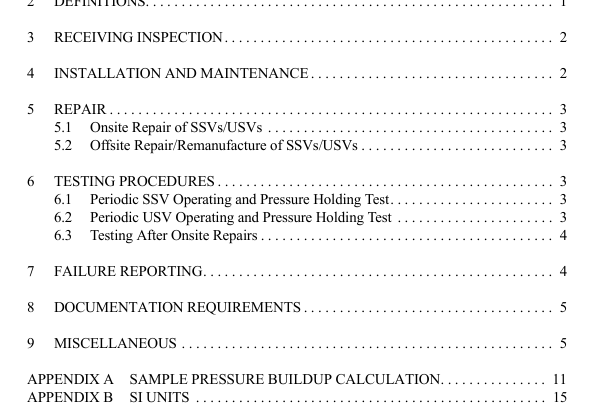API RP 14H:2007 pdf free download.Recommended Practice for Installation, Maintenance and Repair of Surface Safety Valves and Underwater Safety Valves Offshore
5 Repair
5.1 ONSITE REPAIR OF SSVS/USVS
5.1.1 Onsite repair should be accomplished by a qualified person(s).
5.1.2 Onsite repair does not include the replacement of the SSV/USV valve body.
5.1.3 Replacement parts should be qualified parts and should be documented on the SSV/USV Repair Record Sheet (Exhibit 2). Qualified parts shall meet or exceed design requirements for the original parts.
5.1.4 Testing should be performed in accordance with 6.3.
5.1.5 Documentation: completed copies of the SSV/USV Repair Record Sheet (Exhibit 2) and the SSV/USV Functional Test Data Sheet for Onsite Repairs (Exhibit 3).
5.2 OFFSITE REPAIR/REMANUFACTURE OF SSVS/USVS
5.2.1 Offsite repair/remanufacture is not addressed in this RP. These operations should be performed at a facility where the procedures, specifications and quality control allow restoration of the equipment to its original performance meeting the require- ments of the edition of API Specs 6A or 14D in effect at the time of original manufacture, as a minimum. Exhibit 2 and Exhibit 4 may be used for documentation.
6 Testing Procedures
6.1 PERIODIC SSV OPERATING AND PRESSURE HOLDING TEST
6.1.1 SSV Operating Test a. Shut-in well. b. Close SSV. c. Open SSV. d. Return well to production.
6.1.2 SSV Pressure Holding Test a. Shut-in well and SSV as for operation test. b. Position wing and flowline valves to permit pressure to bleed off downstream of SSV. c. With pressure on upstream side of SSV, open bleed valve downstream of SSV and check for continuous flow. If sustained liq- uid flow exceeds 400 cubic centimeters per minute (0.4 cubic decimeters per minute) or gas flow exceeds 15 standard cubic feet per minute (611.6 cubic meters per day) during the pressure holding test, the SSV should be repaired or replaced. Test duration should be a minimum of 5 minutes. d. Close bleeder valve. e. Return well to production.
6.2 PERIODIC USV OPERATING AND PRESSURE HOLDING TEST
6.2.1 USV Operating Test
a. Shut-in well.
b. Close USV.
6.2.2 USV Pressure Holding Test Each operator should use a method appropriate to his system to demonstrate the pressure integrity of the USV and quantify build- up rates.
The following are two options offered for general guidance only: a. Option 1: Perform test as in 6.1.2. b. Option 2: 1. Shut-in well and USV as for operation test (see 6.1.2a and 6.1.2b) and close downstream header or flowline valve. 2. With pressure on upstream side of the USV, measure pressure buildup in the flowline versus time. If the absolute pressure buildup in the confined line segment downstream of the USV is in excess of that which represents a flow rate of 400 cubic centimeters per minute (0.4 cubic decimeter per minute) of liquid or 15 standard cubic feet per minute (611.6 cubic meters per day) of gas, the USV should be repaired or replaced. An example with calculations is given in Appendix A. Test duration should be a minimum of 5 minutes. 3. Return well to production.
6.3 TESTING AFTER ONSITE REPAIRS
6.3.1 General After onsite repair, a SSV/USV should be subjected to the appropriate test(s) listed in 6.3.2 to demonstrate proper assembly and operation. When repair on the SSV/USV actuator does not affect the SSV/USV valve, testing may be limited to that required in 6.1.1 or 6.2.1. The test results should be documented on an SSV/USV Functional Test Data Sheet for Onsite Repairs similar to the example shown in Exhibit 3.
6.3.2 Testing Recommendations for testing SSVs/USVs following onsite repairs are stated below. Testing may be limited according to onsite repairs performed.
6.3.2.1 Onsite repairs where the SSV/USV actuator pressure containing seals are broken or disturbed. The SSV/USV actuator should be tested for leakage using the SSV/USV actuator media. Test pressure should be normal field operating supply pressure. No leakage is allowed.
6.3.2.2 Onsite repairs that might affect the alignment of the gate (plug) and seats. The SSV/USV valve should be opened and checked visually or, if possible, with a drift mandrel for proper alignment.
6.3.2.3 Onsite repairs that might affect operation of the SSV/USV. The complete assembly should be tested for operational integrity; cycle the assembly fully open and fully closed three times with the SSV/USV valve body at ambient pressure or at well- head shut-in tubing pressure (SITP) with no flow. (If equipment through the first downstream block valve will not withstand full wellhead SITP, conduct this test at the working pressure of the downstream equipment.)API RP 14H pdf download.API RP 14H:2007 pdf free download
